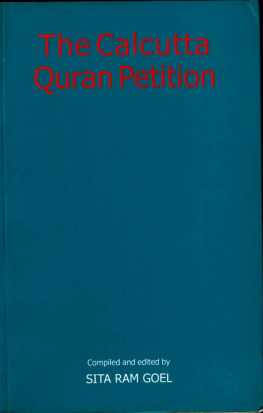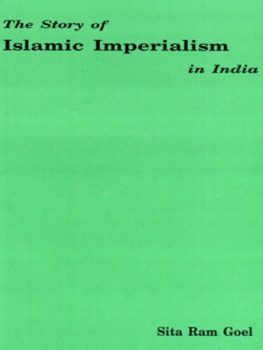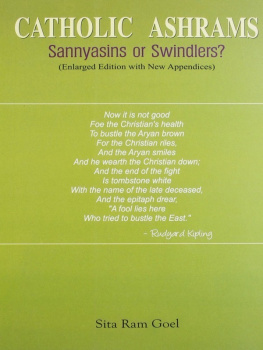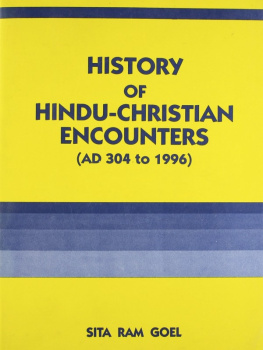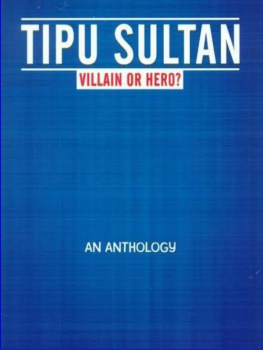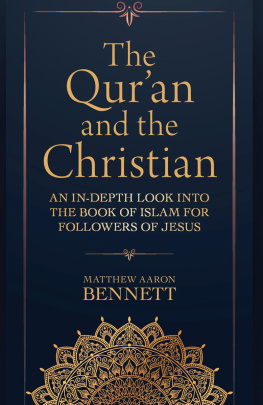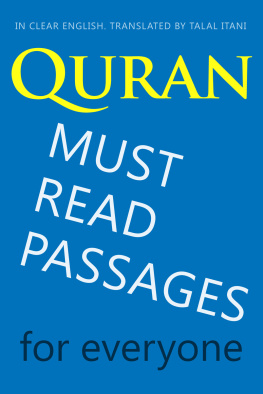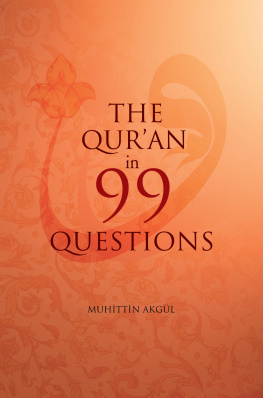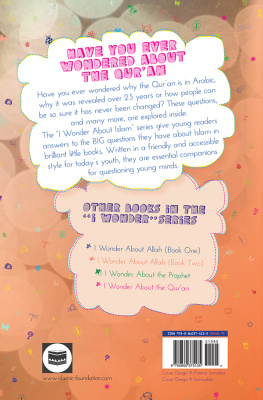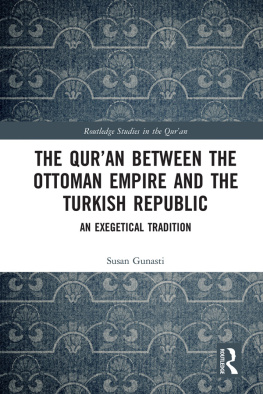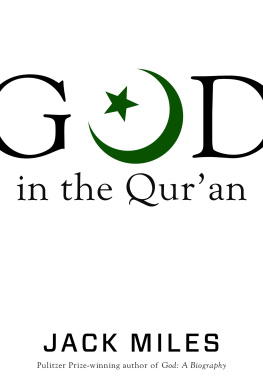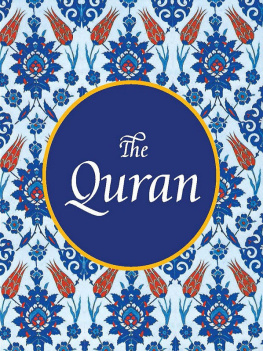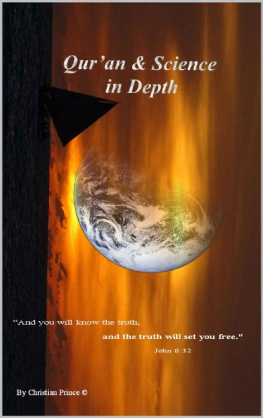Sita Ram Goel - The Calcutta Quran Petition
Here you can read online Sita Ram Goel - The Calcutta Quran Petition full text of the book (entire story) in english for free. Download pdf and epub, get meaning, cover and reviews about this ebook. year: 1999, publisher: Voice of India, genre: History. Description of the work, (preface) as well as reviews are available. Best literature library LitArk.com created for fans of good reading and offers a wide selection of genres:
Romance novel
Science fiction
Adventure
Detective
Science
History
Home and family
Prose
Art
Politics
Computer
Non-fiction
Religion
Business
Children
Humor
Choose a favorite category and find really read worthwhile books. Enjoy immersion in the world of imagination, feel the emotions of the characters or learn something new for yourself, make an fascinating discovery.
- Book:The Calcutta Quran Petition
- Author:
- Publisher:Voice of India
- Genre:
- Year:1999
- Rating:4 / 5
- Favourites:Add to favourites
- Your mark:
- 80
- 1
- 2
- 3
- 4
- 5
The Calcutta Quran Petition: summary, description and annotation
We offer to read an annotation, description, summary or preface (depends on what the author of the book "The Calcutta Quran Petition" wrote himself). If you haven't found the necessary information about the book — write in the comments, we will try to find it.
The Calcutta Quran Petition — read online for free the complete book (whole text) full work
Below is the text of the book, divided by pages. System saving the place of the last page read, allows you to conveniently read the book "The Calcutta Quran Petition" online for free, without having to search again every time where you left off. Put a bookmark, and you can go to the page where you finished reading at any time.
Font size:
Interval:
Bookmark:

Sita Ram Goel
This book was produced in EPUB format by the Internet Archive.
The book pages were scanned and converted to EPUB format automatically. This process relies on optical character recognition, and is somewhat susceptible to errors. The book may not offer the correct reading sequence, and there may be weird characters, non-words, and incorrect guesses at structure. Some page numbers and headers or footers may remain from the scanned page. The process which identifies images might have found stray marks on the page which are not actually images from the book. The hidden page numbering which may be available to your ereader corresponds to the numbered pages in the print edition, but is not an exact match; page numbers will increment at the same rate as the corresponding print edition, but we may have started numbering before the print book's visible page numbers. The Internet Archive is working to improve the scanning process and resulting books, but in the meantime, we hope that this book will be useful to you.
The Internet Archive was founded in 1996 to build an Internet library and to promote universal access to all knowledge. The Archive's purposes include offering permanent access for researchers, historians, scholars, people with disabilities, and the general public to historical collections that exist in digital format. The Internet Archive includes texts, audio, moving images, and software as well as archived web pages, and provides specialized services for information access for the blind and other persons with disabilities.
Created with abbyy2epub (v.1.7.6)
The Writ Petition had placed before the court 85 dyats from the Quran which command Muslims to practise a particular behaviour pattern towards non-Muslims. The point to be considered by the court was whether there was substance in the Petitioners plea that the behaviour pattern prescribed by the Quran was inimical to public peace, communal harmony, and religious beliefs of those who did not subscribe to Islam. The belief system which produces that behaviour pattern should have been evaluated only after evaluating the behaviour pattern in terms of natural justice and common sense.
Justice Basak, however, chose to proceed the other way around. He started by accepting the Muslim claim that the Quran was the word of God. That was his major premise. His minor premise was that if the dyats sounded obnoxious, they must have been tom out of their proper context and interpreted to mean what they did not really mean. The conclusion he drew became unavoidable. How could a belief system based on the word ol God prescribe an ungodly behaviour pattern? So the Quran and the creed embodied in it, posed no threat to public peace or communal harmony or the religious beliefs of non-Muslims. Quod erat demonstrandum.
The fact is that the Quran can pass as a religious scripture only so long as its verses are not related to their concrete context in the life of the Prophet. Once we learn to do that from the theologians of Islam, the Quran comes out in its true colour as a comprehensive compendium on continued and total war against the inlldels. Allah also drops his mask and shows up in his real role as a deux ex machina prompted to pronounce pieces which suit the stagemanager's convenience. Swami Dayananda saw
continued on back flap
Compiled with an introduction by SITA RAM GOEL
VOICE OF INDIA
New Delhi
First Edition, 1986
Second Enlarged Edition, 1987
Third Revised and Enlarged Edition, 1999
ISBN 81-85990-58-1
Published by Voice of India, New Delhi - 110 002 and printed at Book Kraft, Delhi - 110 040.
Preface to Third Edition i
Preface to Second Edition x
Section I: Introduction
1. A Government in Panic 3
2. The Judgment misses the Main Point 16
3. Entire Quran is a Manual on Jihad 43
4. The Prophet sets the Pattern 77
5. The Orthodox Exposition of Jihad 137
6. Jihad in Indias History 157
7. Doctrine of the Islamic State 210
8. Muslim Ummah is a Military Machine 218
9. The Petition has served a Great Purpose 224
10. A Close Look at Allah of the Quran 238
Section II: The Petition and the Judgment
1. Himagshu Kishores Letter 253
2. Himagshu Kishores Reminder 270
3. Notice from Chandmal Chopra 272
4. The Writ Application 275
5. Affidavit in Opposition 289
6. The Judgment 292
Vi / CONTENTS
7. The Review Application 307
8. Review Application Dismissed 319
Bibliography
The first two editions of this book were published in quick succession July 1986 and July 1987 because it was received with great interest and appreciation by the Hindu intelligentsia at large, in this country and abroad. But the present (third) edition has been delayed inordinately in spite of persistent demand after the second edition went out of print in 1988. A reprint of the second edition was not brought out because I wanted to include in a new edition the copious materials which 1 had collected in the meanwhile from orthodox collections of Hadis and which I thought worth presenting to the readers. But that was not to be.
I had finished reading the six authentic Hadis collections Bukhari, Muslim, Tirmizi, Ibn Majah, Ibn Daud, Nasaii which an orthodox Muslim organization had published in several volumes each, with Arabic text and Urdu translation. I had marked in the margins of several thousand pages the relevant references pertaining to the five pillars of Islam, the character of the Muslim Ummah, and the doctrine of jihad. I had noted many stories which provide the context in which particular surahs and ayats of the Quran were revealed; they made it more than clear as to how Allah of the Quran had functioned as a mouthpiece of the Prophet and even some of his companions. But as I started sorting out the references and putting them together under particular themes, I suffered a prolonged spell of illness which persists even as I write
Viii / THE CALCUTTA QURAN PETITION
these lines. So I wait and hope that I will be able to resume the work at some future date.
Some of the material included in the present edition had gone into the computer in the winter of 1990-91. But a lot of new material has been added during 1999. As this edition stands now, I think the reader will find it better arranged and more informative.
The book is still divided into two sections. The second section stands as it did in the earlier editions except that it has been renamed as The Petition and the Judgment instead of Court Documents. The first section, however, has not only been renamed as Introduction instead of Preface, but also carries new insertions, reflections and formulations which have added as many as 50 more pages to it. Many new footnotes have been added, and several new publications cited as the Bibliography at the end goes to show.
The Second Preface to the second edition has been retained intact except that now it stands renamed as, Preface to Second Edition. But sections of the First Preface to the second edition have been rearranged as chapters, most of which have been revised, enlarged and renamed. Chapter 4, The Prophet sets the Pattern, is entirely new. It is a summary of the first orthodox biography of the Prophet, and provides a background to the chapters that follow. Chapter 5, The Orthodox Exposition of Jihad', has been enlarged with extensive passages from Tuhfat-ulMujahideen, a sixteen century (CE) treatise on jihad composed at Bijapur and carrying many citations from orthodox collections of Hadis. In a way, this part of the chapter fulfils to a certain extent my plan to present Hadis materials vis-k-vis jihad. Chapter 6, 4Jihad in Indias History, now includes jihads waged by Sher Shah Sur, Akbar the Great Mughal, and Ahmad Shah Abdali. Many myths have been floated about the secularism of Sher Shah and Akbar by Muslim and Stalinist historians in recent times. Pandit Jawaharlal Nehru, the architect of Indias secularism, has gone to the extent of hailing Akbar as the father of Indian nationalism who deliberately placed the ideal of a
Next pageFont size:
Interval:
Bookmark:
Similar books «The Calcutta Quran Petition»
Look at similar books to The Calcutta Quran Petition. We have selected literature similar in name and meaning in the hope of providing readers with more options to find new, interesting, not yet read works.
Discussion, reviews of the book The Calcutta Quran Petition and just readers' own opinions. Leave your comments, write what you think about the work, its meaning or the main characters. Specify what exactly you liked and what you didn't like, and why you think so.

